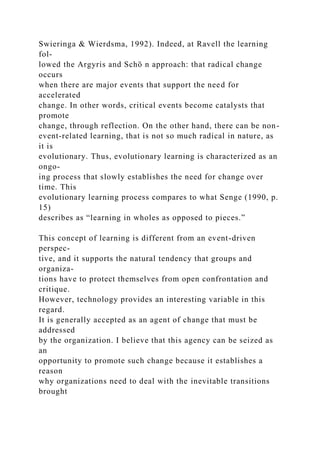This document provides an overview of the history and development of computer networking and the internet. It discusses how ARPANET was developed in the 1960s to enable communication between computers. This evolved into the modern Internet, enabled by protocols like TCP/IP. It describes how the World Wide Web emerged in the 1990s and fueled widespread commercial and personal use of the internet. Broadband technologies further accelerated internet usage by providing high-speed connectivity. Wireless technologies now allow ubiquitous internet access through devices like smartphones.








![has a limit of 3.4×1038 possible addresses. For example, the
domain LinkedIn.com has an IPv6 address of:
[2620:109:c002::6cae:a0a]. You probably noticed that the
address has only five groups of numbers. That’s because IPv6
allows the use of two semi-colons ( :: ) to indicate groups that
are all zeroes and do not need to be displayed. For more detail
about the IPv6 standard, see this Wikipedia article.
• Domain name If you had to try to remember the IP address of
Chapter 5: Networking and Communication | 103
https://en.wikipedia.org/wiki/IPv6
every web site you wanted to access, the Internet would not be
nearly as easy to use. A domain name is a human-friendly
name, convenient for remembering a website. These names
generally consist of a descriptive word followed by a dot
(period) and the Top-Level Domain (TLD). For example,
Wikipedia’s domain name is wikipedia.org. Wikipedia describes
the organization and .org is the TLD. Other well-known TLDs
include .com, .net, and .gov. For a list and description of top](https://image.slidesharecdn.com/chapter5networkingandcommunicationlearningobjecti-230110084940-93bdaa7a/85/Chapter-5-Networking-and-Communication-Learning-Objecti-docx-9-320.jpg)






![The Internet was originally designed as a way for the
Department
of Defense to manage projects. However, the invention of
electronic
mail drove demand for the Internet. While this wasn’t what
developers had in mind, it turned out that people connecting
with
people was the killer app for the Internet. As we look back
today, we
can see this being repeated again and again with new
technologies
that enable people to connect with each other.
Sidebar: The Internet and the World Wide Web
1. [1]
Chapter 5: Networking and Communication | 107
Are Not the Same Thing
Many times the terms “Internet” and “World Wide Web,” or
even
just “the web,” are used interchangeably. But really, they are
not the
same thing.](https://image.slidesharecdn.com/chapter5networkingandcommunicationlearningobjecti-230110084940-93bdaa7a/85/Chapter-5-Networking-and-Communication-Learning-Objecti-docx-16-320.jpg)



![a human need – it is a right.”3
Wireless Networking
Thanks to wireless technology, access to the Internet is virtually
everywhere, especially through a smartphone.
Wi-Fi
Wi-Fi takes an Internet signal and converts it into radio waves.
2. [2]
3. [3]
Chapter 5: Networking and Communication | 109
http://www.un.org/apps/news/story.asp?Cr=broadband&NewsID
=40191#.UZlTSyvSOPU
http://www.un.org/apps/news/story.asp?Cr=broadband&NewsID
=40191#.UZlTSyvSOPU
http://www.unesco.org/new/en/unesco
http://www.itu.int/
http://www.broadbandcommission.org/Documents/Broadband_C
hallenge.pdf
These radio waves can be picked up within a radius of
approximately 65 feet by devices with a wireless adapter.
Several
Wi-Fi specifications have been developed over the years,
starting](https://image.slidesharecdn.com/chapter5networkingandcommunicationlearningobjecti-230110084940-93bdaa7a/85/Chapter-5-Networking-and-Communication-Learning-Objecti-docx-20-320.jpg)



![the bottom line is that phones using one standard cannot easily
switch to the other. This is not a big deal in the US because
mobile
networks exist to support both standards. But when traveling to
other countries, you will find that most of them use GSM
networks.
The one exception is Japan which has standardized on CDMA.
It is
possible for a mobile phone using one type of network to switch
to the other type of network by changing out the SIM card,
which
controls your access to the mobile network. However, this will
not
4. [4]
Chapter 5: Networking and Communication | 111
work in all cases. If you are traveling abroad, it is always best
to
consult with your mobile provider to determine the best way to
access a mobile network.
Bluetooth](https://image.slidesharecdn.com/chapter5networkingandcommunicationlearningobjecti-230110084940-93bdaa7a/85/Chapter-5-Networking-and-Communication-Learning-Objecti-docx-24-320.jpg)





































